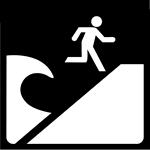Tsunami warnings: how to respond
24 August 2011
The Joint Australian Tsunami Warning Centre (JATWC) is operated by the Bureau of Meteorology and Geoscience Australia 24 hours a day. The Centre's role is to detect, monitor, verify and warn of any tsunami threats to the coastline of Australia and its offshore territories. Find out about the Centre's various tsunami warning products and what action to take should you receive one.
This is an excellent example of a marine tsunami. In this case, disruption to normal marine conditions in the Heathcote and Avon Estuary (Christchurch, New Zealand) can be seen as a tsunami comes through. This event was the result of a large earthquake and tsunami that occurred off Chile in February 2010 – approximately 9000 km away! This video footage was filmed by Viv Head whose Youtube Channel can be viewed at http://www.youtube.com/user/vivhead1.
If there was one overriding lesson from the series of deadly tsunamis seen over the past decade, it is this: early warnings can, and do, save lives.
While Australia may not be as vulnerable as many of our neighbours, coastal communities and maritime users can still face serious dangers from changing sea conditions and, in the worse case, flooding of low-lying coastal areas, due to tsunamis caused by undersea earthquakes. Fortunately, we have access to a world-class tsunami monitoring and warning service operated by the Joint Australian Tsunami Warning Centre.
When a tsunami threat occurs, the Centre begins issuing real-time warnings and advice to emergency services, local authorities, police, the media and the public within 15-30 minutes. As well as a steady flow of information on the threat, the Centre provides regular public updates and response advice from emergency services through the tsunami warning service.
Joint Australian Tsunami Warning Centre Products
Tsunami Watch
Issued within 30 minutes of an earthquake if there is a potential threat to Australia. The Joint Australian Tsunami Warning Centre is verifying that a tsunami has actually been generated.
Action: Be aware there is a potential tsunami threat. Make preparations and stand by for further updates. At this stage there is no need for further action.
Tsunami Warning – Marine Threat
Issued for coastal waters threatened by dangerous ocean conditions once a tsunami is confirmed OR if the potential impact to Australia is anticipated to occur in less than 90 minutes.
Action: Be aware of potential hazards from strong rips, abnormal currents and dangerous waves. Get out of the water, secure boats and move away from beaches, marinas, estuaries and rock platforms. Any possible flooding will most likely be limited to the immediate foreshore. Major evacuations are therefore not required.
Tsunami Warning – Land Threat
Issued for low-lying coastal regions under threat of flooding and dangerous ocean conditions, once a tsunami is confirmed OR if the potential impact is anticipated to occur in less than 90 minutes.
Action: Be aware of potential hazards from major coastal flooding, dangerous waves and strong rips and currents. If your area is advised to be under threat, move to higher ground -10 m above sea level or 1k m inland.
Cancellation
Issued when the main threat has passed or a tsunami did not occur.
Action: Even though the tsunami warning has been cancelled, unusual rips, tides and currents may persist for several hours. If there has been damage due to a tsunami, it may also be sometime before it's safe to enter affected areas. Emergency services will advise the 'All Clear' when it is safe to return.
Accurate tsunami warning information
The Joint Australian Tsunami Warning Centre is the national authority and provides the most accurate tsunami warning information for Australia. Information from sources outside Australia could be misleading.
When a tsunami threatens:
- Stay tuned to the media or our tsunami warning service for the latest advice issued by the Centre (1300 TSUNAMI or bom.gov.au/tsunami)
- Listen for information about emergency arrangements from the lead emergency service agency in your State or Territory.


Comment. Tell us what you think of this article.
Share. Tell others.